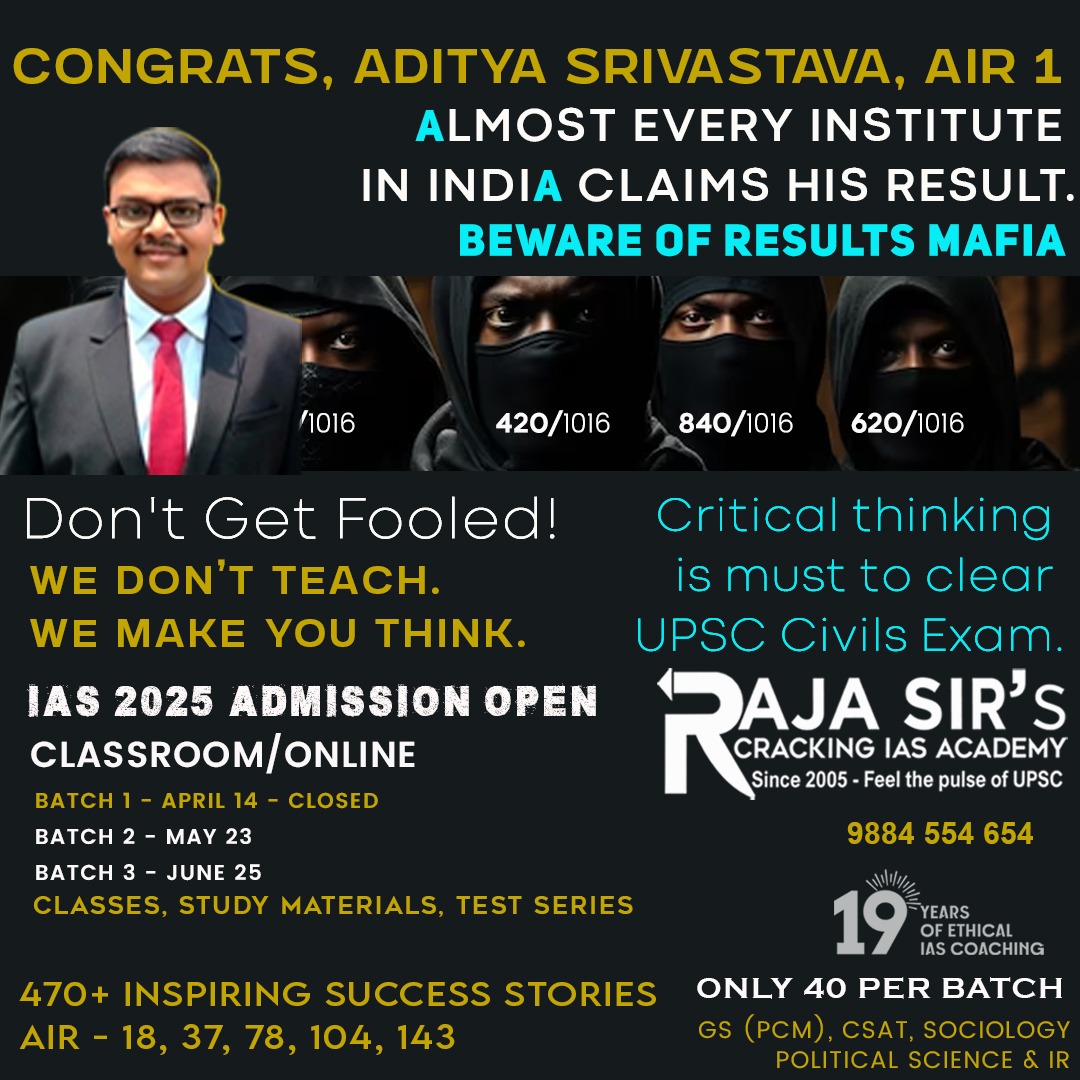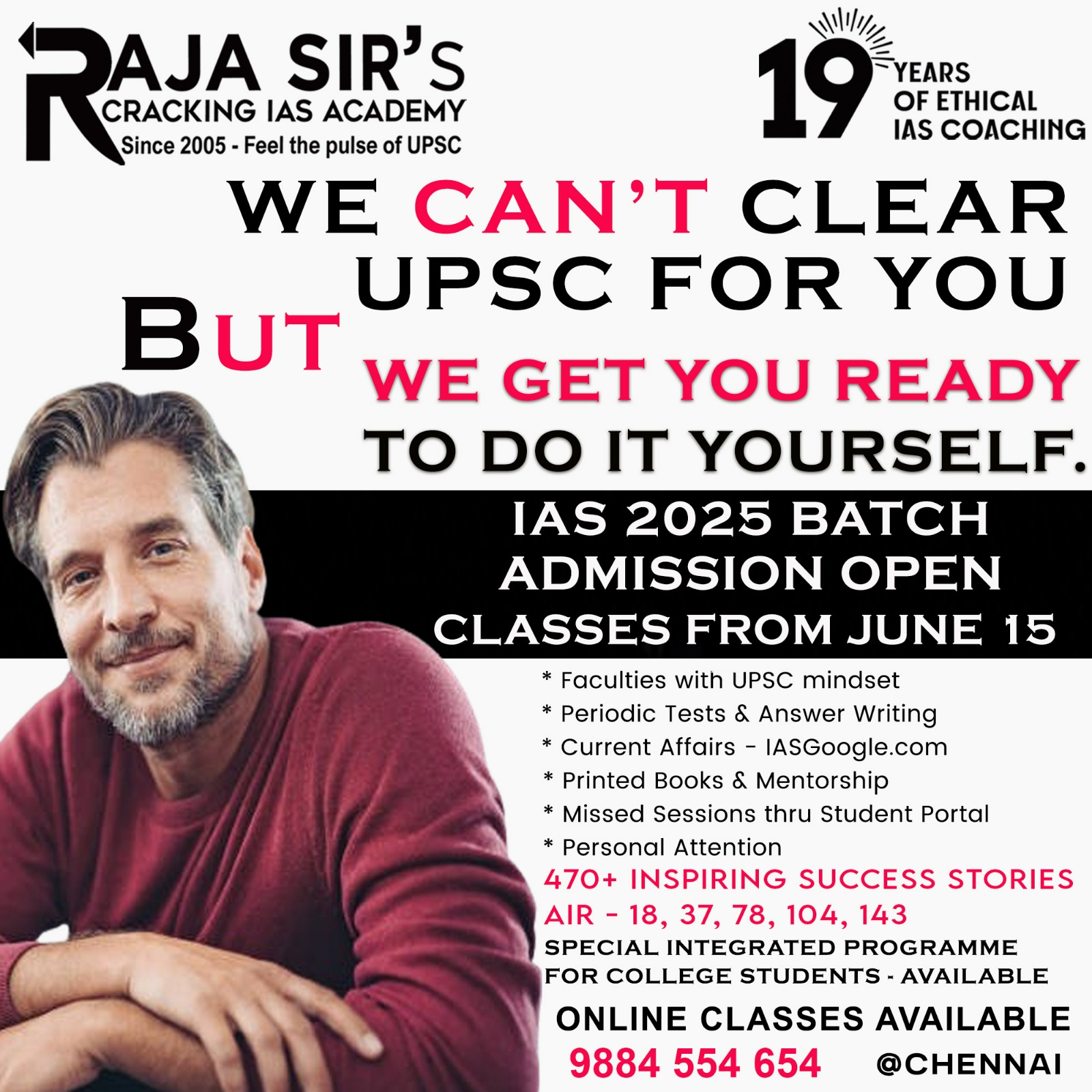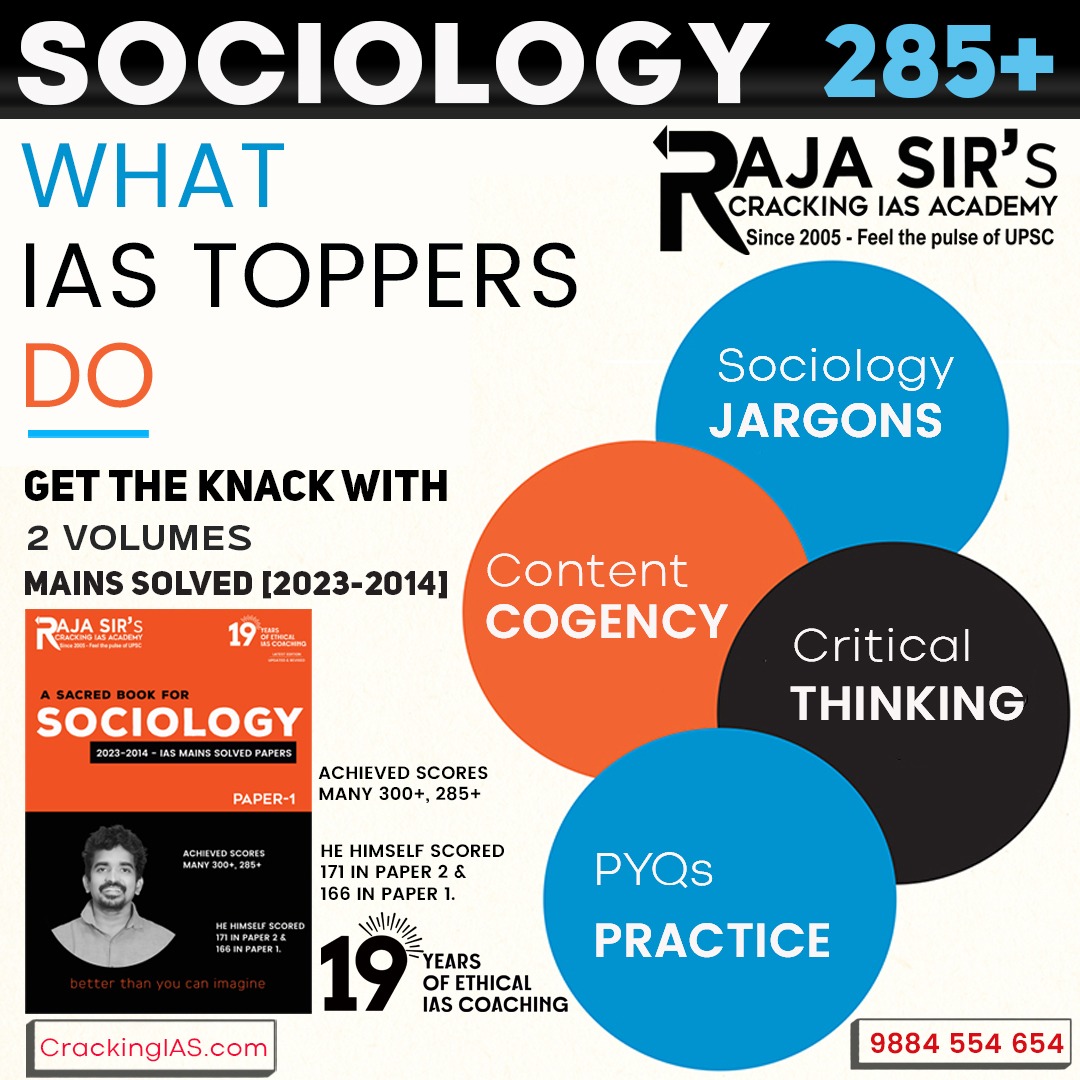- Home
- Prelims
- Mains
- Current Affairs
- Study Materials
- Test Series
Hit List Questions 43-PPP 100 PRELIMS 2024 - 61
Questions & Explanations:
|
1. |
1. He was the 24th Tirthankar of Jainism. 2. He delivered his first sermon at Pava. 3. His father Siddharta was the head of the Jnathrika Kshatriya clan. 4. His mother Trishala was a sister of Chetaka, the king of Vaishali. Which of the given statements is/are correct w.r.t. Vardhamana Mahavira? (a) 1, 2, 3, 4 (b) 1, 2, 3 (c) 2, 3, 4 (d) 1, 3, 4
|
|
|
2. |
1. Gandatindu Jataka describes the plight of the subjects of a Wise king. 2. Buddhagosa is said to have gathered about 550 Jataka stories. 3. The Jatakas describe the previous existences or births of the Buddha. 4. In Matanga Jataka the Bodhisatta is identified as a chandala. Identify the correct statements using the codes given below. (a) 1, 2 and 3 only (b) 2 and 3 only (c) 2, 3 and 4 only (d) 1, 2, 3, 4
|
|
|
3. |
GHG Protocol includes (a) seven gases which includes nitrogen trifluoride. (b) seven gases which excludes nitrogen trifluoride. (c) five gases which includes nitrogen trifluoride. (d) five gases which excludes nitrogen trifluoride.
|
|
|
4. |
(i) Mahapajapati Gotami persuaded Buddha to allow women into the sangha. (ii) Many women who entered the sangha became teachers of Dhamma and went on to become theris. (iii) Once within the sangha, all were regarded as equal. How many of the above statements is/are correct w.r.t. “Sangha”?. (a) Only two (b) Only one (c) All the three (d) None of these
|
|
|
5. |
‘Kutagarashala’ in ancient India, referred to (a) a place where Brahman family were given education. (b) a place where the head of a tribe resided. (c) a place where the debate between philosophers took place. (d) A place where the mortal remains of monks were preserved.
|
|
|
6. |
I. It was a three-way struggle between the Pratihara Empire, the Pala Empire and the Rashtrakuta Empire. II. It was for the control of Kannauj. Which of the statements given above is/are correct w.r.t. The Tripartite Struggle? (a) Only I (b) Only II (c) Both I & II (d) Neither I nor II
|
|
|
7. |
Which Bhakti Saint did not believe in the qualified monism of Ramanuja and emphasised the doctrine of duality, based mainly upon the Bhagavata Purana? (a) Madhava (b) Ramananda (c) Vallabhacharya (d) Chaitnaya
|
|
|
8. |
Following is connected with Jahangir’s reign in India 1. introduction of ‘Do-aspa and Sih-aspa’ system 2. signing of Treaty of Chittor 3. visit of Francisco Pelsaert 4. killing of Abul Fazl Which of the following is the correct combo in this regard? (a) 2 and 3 only (b) 3 and 4 only (c) 1 and 3 only (d) 1, 2, 3 and 4
|
|
|
9. |
Consider the following statements w.r.t. Bhimbetka rock shelters of Madhya Pradesh. 1. A two-horned rhino, 30 cm in length, was found drawn with a red pigment — obtained from haematite, an iron ore. 2. It was discovered by Dr. Vishnu Wakankar. (a) Only (1) is true (b) Only (2) is true (c) Both (1) & (2) are true (d) Neither (1) Nor (2) is true
|
|
|
10. |
I. The caves are located within the forests of the Sanjay Gandhi National Park. II. It was mentioned in the travelogues of Fa-Hein. Which of the above statements is/are true w.r.t. Kanheri Caves? (a) Only I (b) Only II (c) Both I & II (d) Neither I nor II
|
|
|
11. |
Which one of the following is correct w.r.t. India’s Heritage Sites?. (a) Bhubadanga is not a UNESCO World Heritage Site. (b) India has the largest number of UNESCO World Heritage Sites sites in the world. (c) Khangchendzonga National Park, is of mixed type heritage site. (d) The Sacred Ensembles of Hoysalas, is nominated for UNESCO Natural Heritage site.
|
|
|
12. |
1. There are eight ceremonial gateways. 2. On its southern side, the Ashokan Lion Capital pillar is found with inscriptions on it. 3. It was vandalised by Pushyamitra Shunga. Which of the statements given above is/are correct w.r.t. Sanchi stupa? (a) Only 1 and 2 (b) Only 3 (c) Only 2 and 3 (d) Only 1 and 3 o |
|
|
13. |
Which one of the following statements about the Bilhana is NOT correct? (a) He was in love with Princess Yaminipurnatilaka, daughter of King Madanabhirama. (b) He is known for his poem “Chaura-panchasika”. (c) Vikramankadevacharita was authored by him. (d) He authored ‘Mitakshara’.
|
|
|
14. |
I. Akbar constructed Panch Mahal inspired by a Buddhist temple. II. Akbar had built Jahangir Mahal in Agra Fort. Which of the statements given above is/are correct w.r.t. Akbar? (a) Only I (b) Only II (c) Both I & II (d) Neither I nor II
|
|
|
15. |
1. Emergence of states, cities, and towns 2. Use of iron 3. Dominance of Hinduism 4. Emergence of Buddhism and Jainism The sixth century BCE is often considered a major turning point in Indian history due to (a) 1 and 2 only (b) 2 and 3 only (c) 1 and 3 only (d) 2 and 4 only
|
|
|
16. |
Which one of the following texts of ancient India allows divorce to a wife deserted by her husband? (a) Kamasutra (b) Manavadharmashastra (c) Sukra Nitisara (d) Arthashastra
|
|
|
17. |
I. It is well known for the ruins of a Buddhist stupa discovered there by Major General Alexander Cunningham in 1873. II. Buddha has been represented in the form of symbols. III. Queen Maya’s dream, preceding the birth of the Buddha, is a major theme on the railing of the Bharhut “stupa”. Which of the above statements is/are true w.r.t. Bharhut stupa?. (a) Only I & II (b) Only II & III (c) Only I & III (d) I, II & III
|
|
|
18. |
Identify the incorrect pair. (Traveller) (Country) (a) Ibn Batuta Morocco (b) Marco Polo Italy (c) Abdur Razaaq Turkey (d) Nuniz Portugal
|
|
|
19. |
Which of following statement is correct regarding the amara-nayakas system? (a) The amara-nayakas were traders. (b) Main features of this system were derived from the mansabdari system. (c) King had no control over the amara-nayakas. (d) The amara-nayakas were military commanders who were given territories to govern.
|
|
|
20. |
PRET initiative in news was launched by (a) WHO (b) WEF (c) GEF (d) WWF
|
|
|
21. |
1. Indian Carbon Market will be administered by NEERI. 2. Indian Carbon Market will facilitate achieve the Nationally Determined Contributions goal of reducing Emissions Intensity of the GDP by 45 percent by 2045 against 2005 levels. Which of the above statements is/are correct w.r.t. Indian Carbon Market? (a) 1 only (b) 2 only (c) Both 1 and 2 (d) Neither 1 nor 2
|
|
|
22. |
1. It was an initiation made by Iltutmish. 2. It was destroyed by the Gayasuddin Balban. Which of the statements given above is/are correct w.r.t. Chahalgani? (a) 1 only (b) 2 only (c) Both 1 and 2 (d) Neither 1 nor 2
|
|
|
23. |
1. Reign of Krishna Deva of Vijayanagara 2. Construction of Qutb Minar 3. Arrival of Portuguese in India 4. Death of Firuz Tughluq The correct chronological sequence of these events is: (a) 2, 4, 3, 1 (b) 2, 4, 1, 3 (c) 4, 2, 1, 3 (d) 4, 2, 3, 1
|
|
|
24. |
Which one among the following is incorrect w.r.t. reign of Shah Jahan? (a) He shifted the capital from Agra to Delhi. (b) He built Jama Masjid of Delhi. (c) Poet Kaleem was in the court of Shah Jahan. (d) The motive behind Shah Jahan’s Balkh and Badakshan campaign was to conquer Samarqand and Ferghana.
|
|
|
25. |
Which of the following is/are famous for Sun temples? 1. Arasavalli 2. Katarmal 3. Unao (a) 1 only (b) 2 and 3 only (c) 1 and 3 only (d) 1, 2 and 3
|
|
EXPLANATIONS
|
1. |
https://iasgoogle.com/editorial/abc-of-jainism Agamas - The texts containing the teachings of Mahavira are called the Agamas and are the canonical literature - the scriptures - of Svetambara Jainism. Mahavira''s disciples compiled his words into texts or sutras and memorized them to pass on to future generations. Kalpa Sutra - It was written by Bhadrabahu. It contains the biographies of the Jain Tirthankaras, most notably Parshvanath and Mahavira, including the latter’s Nirvana. Since Bhadrabahu was a teacher of Chandragupta Maurya, we can say that it was compiled in Mauryan Era. Sutta Pitaka - The Basket of Discourse- contains sermons and doctrinal and ethical discourses attributed to the Buddha or sometimes to his disciples. |
||||||||||||||||||||||||||||||||||||
|
2. |
One story known as the Gandatindu Jataka describes the plight of the subjects of a wicked king; these included elderly women and men, cultivators, herders, village boys and even animals. When the king went in disguise to find out what his subjects thought about him, each one of them cursed him for their miseries, complaining that they were attacked by robbers at night and by tax collectors during the day. To escape from this situation, people abandoned their village and went to live in the forest. As this story indicates, the relationship between a king and his subjects, especially the rural population, could often be strained – kings frequently tried to fill their coffers by demanding high taxes, and peasants particularly found such demands oppressive. Escaping into the forest remained an option, as reflected in the Jataka story. Meanwhile, other strategies aimed at increasing production to meet growing demand for taxes also came to be adopted. Matanga Jataka, a Pali text, contains the story where the Bodhisatta or the Buddha in a previous birth is identified as a chandala. In this story of Matanga Jataka notes the Bodhisatta is born outside the city of Banaras as a Chandala''s son and named Matanga. |
||||||||||||||||||||||||||||||||||||
|
3. |
The GHG Protocol Corporate Accounting and Reporting Standard provides requirements and guidance for companies and other organizations preparing a corporate-level GHG emissions inventory. The standard covers the accounting and reporting of seven greenhouse gases covered by the Kyoto Protocol – carbon dioxide (CO2), methane (CH4), nitrous oxide (N2O), hydrofluorocarbons (HFCs), perfluorocarbons (PCFs), sulphur hexafluoride (SF6) and nitrogen trifluoride (NF3). It was updated in 2015 with the Scope 2 Guidance, which allows companies to credibly measure and report emissions from purchased or acquired electricity, steam, heat, and cooling. |
||||||||||||||||||||||||||||||||||||
|
4. |
Initially, only men were allowed into the sangha, but later women also came to be admitted. According to Buddhist texts, this was made possible through the mediation of Ananda, one of the Buddha’s dearest disciples, who persuaded him to allow women into the sangha. Buddha’s foster mother, Mahapajapati Gotami was the first woman to be ordained as a bhikkhuni. |
||||||||||||||||||||||||||||||||||||
|
5. |
We get a glimpse of lively discussions and debates from Buddhist texts, which mention as many as 64 sects or schools of thought. Teachers traveled from place to place, trying to convince one another as well as laypersons, about the validity of their philosophy or the way they understood the world. Debates took place in the Kutagarashala – a hut with a pointed roof – or in groves where traveling mendicants halted. If a philosopher succeeded in convincing one of his rivals, the followers of the latter also became his disciples. So support for any particular sect could grow and shrink over time. |
||||||||||||||||||||||||||||||||||||
|
6. |
The tripartite struggle in northern India refers to the period of political instability and conflict that occurred after the decline of Harsha''s empire, roughly from the mid-7th century to the 10th century. This era witnessed a power vacuum and intense competition among three major powers: the Pala Empire, the Pratihara Empire, and the Rashtrakuta Empire. Factors leading to the tripartite struggle:
Economic Factors: Economic decline and the breakdown of trade routes, partly due to the fall of the Gupta Empire and the decline of the Silk Road, impacted the prosperity of the region. Economic hardships may have fueled local conflicts as rulers sought to control resources.
Rise of Feudal Chieftains: Vassal rulers and autonomous chiefs confined the direct rule of the king, engaging in frequent wars that resulted in fragmented political power, preventing the emergence of a single dominant kingdom.
Consequences of the Tripartite Struggle:
Consolidation of Regional Powers: The Pala Empire in the east, the Pratihara Empire in the northwest, and the Rashtrakuta Empire in the Deccan emerged as major regional powers.
Strained Economy: The constant need for resources to fund military campaigns strained the economic foundations of the empires.Cultural and Religious Diversity: The tripartite struggle allowed for the preservation and promotion of diverse cultures and religious practices. Different regions adopted distinct cultural identities, contributing to the rich tapestry of Indian history.
Military Innovations: The constant conflicts prompted rulers to invest in military innovations and strategies.
Art and Architecture: Local rulers patronized the arts, leading to the construction of temples, sculptures, and other architectural marvels that reflected regional styles.
ConclusionThe tripartite struggle in northern India was a complex interplay of political, economic, religious, and cultural factors. While it led to political fragmentation and localized rule, it also fostered cultural diversity and laid the groundwork for the subsequent regional powers that shaped the history of medieval India. |
||||||||||||||||||||||||||||||||||||
|
7. |
https://iasgoogle.com/editorial/madhvacharya-and-brahma-mimansa |
||||||||||||||||||||||||||||||||||||
|
8. |
The coronation of Jahangir took place on 3 November, 1605 AD. A week after the death of Akbar he assumed the title of ‘Nuruddin Muhammad Jahangir Badshah Ghazi.’ He provided high designations to his associates in his court in which the murderer of Abul Fazl, Raja Vir Singh Bundela was also rewarded. Jahangir started his reign with liberalism forwarding the customs and traditions of his father Akbar and issued the orders which demonstrated concern for the welfare of the people. The Mughal painting reached its zenith under the reign of Jahangir. Earlier, the paintings were concerned with the contents of manuscripts, but Jahangir freed it from this bondage. Farrukh Beg, Daulat, Mansoor, Abul Hasan, etc. were such painter who had inscribed their name in a golden word in the history of Mughal painting with their talent. Ustad Mansoor and Abul Hassan was an excellent painter of Jahangir’s reign. Emperor Jahangir bestowed both Nadir-ul- Indian History General Studies Asra (Ustad Mansoor) and Nadir-ul-Zaman (Abul Hassan). Ustad Mansoor was specialized in depicting plants and animal while Abul Hassan was a portrait artist. Sir Thomas Roe visited India during the reign of Jahangir as a British ambassador. As a representative of England King James-I, Sir Thomas Roe (1615-1619) narrated a clear picture of Jahangir’s rule. He was sent to Mughal Court to acquire favourable facilities for the trade of British with India. ‘Do-aspa and Sih-aspa’ system was introduced by Jahangir. Under the provision of this system, Mansabdars had to maintain an excess number of soldiers without increment in rank (zat). Do-aspa : In this system, Mansabdars had to maintain double horses in comparison to their ‘Sawar’ rank. Sih-aspa : In this system, Mansabdars had to maintain a triple number of horses in comparison to their ‘Sawar’ rank. It was the reign of Jahangir in which the ‘’Treaty of Chittor’’ was signed between Mughals and Rana of Mewar in 1615. Rana accepted the allegiance of Mughal emperor and Jahangir returned Mewar and Chittorgarh to Rana which were annexed by Mughals during the reign of Akbar. |
||||||||||||||||||||||||||||||||||||
|
9. |
|
||||||||||||||||||||||||||||||||||||
|
10. |
|||||||||||||||||||||||||||||||||||||
|
11. |
|||||||||||||||||||||||||||||||||||||
|
12. |
The most eye-catching aspects of Sanchi Stupa are the four entrances, or toranas.
|
||||||||||||||||||||||||||||||||||||
|
13. |
|
||||||||||||||||||||||||||||||||||||
|
14. |
Akbar constructed various buildings at his new capital Fatehpur Sikri. Panch Mahal was a fi ve-storeyed pavilion and built on the pattern of a Buddhist monastery which exists in very few places in India. This monument style is inspired by multi-storey buildings of Nalanda. Agra Fort is the earliest example of Akbari style.This fort was built by Akbar. This monument was erected in the guidance of the chief architect of Akbar, Kasim Khan. Akbar had built more than 500 buildings in the fort by red sandstones. Jahangir Mahal is located inside of the Agra Fort. This palace was constructed for Shahzada Salim by Akbar. Jahangir Palace is one of the top examples of Mughal architecture with intricate Hindu and Islamic motifs. The architecture of Jahangir palace is inspired by the palace of Man Singh of Gwalior. |
||||||||||||||||||||||||||||||||||||
|
15. |
The sixth century BCE is often considered a major turning point in Indian history due to several significant developments that took place during this time. One of the key factors that contributed to this transformation was the emergence of states, cities, and towns, along with the widespread use of iron. These two factors, when combined, brought about significant changes in various aspects of Indian society and laid the foundation for future developments. |
||||||||||||||||||||||||||||||||||||
|
16. |
Artha-shastra, (“The Science of Material Gain”) also spelt Artha-śāstra, singularly important Indian manual on the art of politics, attributed to Kautilya (also known as Chanakya), who reportedly was chief minister to the emperor Chandragupta (c. 300 BCE), the founder of the Mauryan dynasty. Although it is unlikely that all of the text dates to such an early period, several parts have been traced back to the Mauryas. The author of the Artha-shastra is concerned with the ruler’s central control of a realm of fairly limited size. Kautilya wrote about the way the state’s economy is organized, how ministers should be chosen, how war should be conducted, and how taxation should be arranged and distributed. Emphasis is placed on the importance of a network of runners, informers, and spies, which, in the absence of a ministry of public information and a police force, functioned as a surveillance corps for the ruler, focusing particularly on any external threats and internal dissidence. According to the Arthashastra, marriage can end if dissolved by mutual consent and should be unapproved marriage.
|
||||||||||||||||||||||||||||||||||||
|
17. |
|||||||||||||||||||||||||||||||||||||
|
18. |
Ibn Batuta (1333-1347 AD) was a traveller from Morocco. He came to India during the tenure of Muhammad Bin Tughluq. Marco Polo was a famous traveller from Venice (Italy). He visited India during the rule of Pandya ruler Marvarman Kulshekhara (1268-1310 AD). Iranian Ambassador Abdur Razzaq visited Vijayanagara during the rule of Devrai II (1422-46 AD). Nuniz was a Portguese traveller. He also visited Vijayanagara. https://iasgoogle.com/editorial_detail/foreign-travelers-who-visited-india
|
||||||||||||||||||||||||||||||||||||
|
19. |
The Amara-Nayaka system was a major political innovation of the Vijayanagar Empire. It is likely that many features of this system were derived from the IQTA system of the Delhi Sultanate. The Amara-Nayakas were military commanders who were given territories to govern. They collected taxes and other dues from peasants, crafts persons and traders in the area. They retained part of the revenue for personal use and for maintaining a stipulated contingent of horses and elephants. |
||||||||||||||||||||||||||||||||||||
|
20. |
|||||||||||||||||||||||||||||||||||||
|
21. |
|||||||||||||||||||||||||||||||||||||
|
22. |
When Iltutmish took charge of the Delhi sultanate, he decided to organize an administration in order to lay the foundation for future dominance over north India. he organized a group of forty nobles who had important roles in the administration of Delhi Sultanate. They all were Turkish nobles who excelled in their fields. He named the group Chahalgani. The Iltutmish divided the empire into different divisions called Iqtas. These divisions were assigned to the nobles and officers in lieu of salary. He constructed many historical structures, including mosques, khanqahs (monasteries), dargahs (shrines or graves of influential people) and a reservoir (hawz) for pilgrims. It was destroyed by the Gayasuddin Balban. He himself was a member of Chalisa or Chahalgani. Balban ascended the throne in 1266, After killing all the members of the Illtutmish family. He abolished Chahalgani because of the growing influence of Chahalgani or Chalisa in the administration.
|
||||||||||||||||||||||||||||||||||||
|
23. |
Krishnadevaraya was an emperor of the Vijayanagara Empire who reigned from 1509–1529. He is the third ruler of the Tuluva Dynasty. Krishna Deva Raya benefited from the able Prime Minister Timmarusu, who was regarded by the emperor as a father figure and was responsible for his coronation. • Qutab Minar is a 73 m-high tower of victory, built in 1193 by Qutab-ud-din Aibak immediately after the defeat of Delhi''s last Hindu kingdom. The tower has five distinct storeys, each marked by a projecting balcony and tapers from a 15 m diameter at the base to just 2.5 m at the top. • It was the Portuguese who first discovered a direct sea route to India. Portuguese sailor Vasco da Gama arrived at Calicut an important sea port located on the South-West India on May 20, 1498 AD. • Sultan Firoz Shah Tughlaq was a Turkic Muslim ruler of the Tughlaq Dynasty, who reigned over the Sultanate of Delhi from 1351 to 1388. His father''s name was Rajab who had the title Sipahsalar. He died in 1388. |
||||||||||||||||||||||||||||||||||||
|
24. |
The motive behind Shah Jahan’s Balkh and Badakshan campaign was not to conquer Samarqand and Ferghana, the Mughal homeland but to remove the Persian representative and secure a friendly ruler in Balkh and Badakshan which bordered Kabul. This would help him in controlling the rebel Afghan tribes living near Ghazni and Khyber. So, it became a buff er state between Mughals and Persians. Jama Masjid of Delhi was built up by Shah Jahan. He left behind a great legacy of structures constructed during his reign. Buildings constructed by Shah Jahan are Diwan-iAam, Diwan-i-Khas, Shish Mahal, Moti Masjid, Khas Mahal, Musamman Burj, Nagina Masjid, Jama Masjid, Taj Mahal and Red Fort. In 1638, Shah Jahan transferred his capital from Agra to Delhi and laid the foundations of Shahjahanabad on his name. Red Fort (build in 1648) is an important monument of Shah Jahan. It is an irregular octagon with two long sides on the west and east and with two main gates, one on the west and the other on the south called Lahori and Delhi gates respectively. It is unique in architecture and glory.
|
||||||||||||||||||||||||||||||||||||
|
25. |
Sun Temple at Modhera:
Modheshwari Mata Temple:
Other Sun Temples · Sun Temple at Konark, Odisha · Martand Sun temple, Kashmir · Katarmal Sun Temple, Uttarakhand · Dakshinarkaa temple Gaya, Bihar · Bhramanya temple, Unao, Madhya Pradesh · Surya Prahaar temple, Assam · Suryanar Kovil Temple at Kumbakonam in Tamil Nadu · Suryanarayana temple at Arasavalli, Andhra Pradesh |









 Latest News
Latest News




 General Studies
General Studies